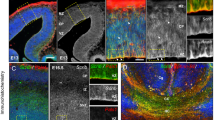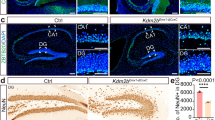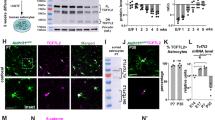Abstract
Social interaction is a fundamental behavior in all animal species, but the developmental timing of the social neural circuit formation and the cellular and molecular mechanisms governing its formation are poorly understood. We generated a mouse model with mutations in two Disheveled genes, Dvl1 and Dvl3, that displays adult social and repetitive behavioral abnormalities associated with transient embryonic brain enlargement during deep layer cortical neuron formation. These phenotypes were mediated by the embryonic expansion of basal neural progenitor cells (NPCs) via deregulation of a β-catenin/Brn2/Tbr2 transcriptional cascade. Transient pharmacological activation of the canonical Wnt pathway during this period of early corticogenesis rescued the β-catenin/Brn2/Tbr2 transcriptional cascade and the embryonic brain phenotypes. Remarkably, this embryonic treatment prevented adult behavioral deficits and partially rescued abnormal brain structure in Dvl mutant mice. Our findings define a mechanism that links fetal brain development and adult behavior, demonstrating a fetal origin for social and repetitive behavior deficits seen in disorders such as autism.
This is a preview of subscription content, access via your institution
Access options
Subscribe to this journal
Receive 12 print issues and online access
$259.00 per year
only $21.58 per issue
Buy this article
- Purchase on Springer Link
- Instant access to full article PDF
Prices may be subject to local taxes which are calculated during checkout






Similar content being viewed by others
References
Rudie JD, Shehzad Z, Hernandez LM, Colich NL, Bookheimer SY, Iacoboni M et al. Reduced functional integration and segregation of distributed neural systems underlying social and emotional information processing in autism spectrum disorders. Cereb Cortex 2012; 22: 1025–1037.
Hagmann P, Cammoun L, Gigandet X, Meuli R, Honey CJ, Wedeen VJ et al. Mapping the structural core of human cerebral cortex. PLoS Biol 2008; 6: e159.
Normand EA, Crandall SR, Thorn CA, Murphy EM, Voelcker B, Browning C et al. Temporal and mosaic Tsc1 deletion in the developing thalamus disrupts thalamocortical circuitry, neural function, and behavior. Neuron 2013; 78: 895–909.
Lui JH, Hansen DV, Kriegstein AR . Development and evolution of the human neocortex. Cell 2011; 146: 18–36.
Kuwahara A, Hirabayashi Y, Knoepfler PS, Taketo MM, Sakai J, Kodama T et al. Wnt signaling and its downstream target N-myc regulate basal progenitors in the developing neocortex. Development 2010; 137: 1035–1044.
Munji RN, Choe Y, Li G, Siegenthaler JA . Pleasure SJ. Wnt signaling regulates neuronal differentiation of cortical intermediate progenitors. J Neurosci 2011; 31: 1676–1687.
Sokol SY, Klingensmith J, Perrimon N, Itoh K . Dorsalizing and neuralizing properties of Xdsh, a maternally expressed Xenopus homolog of dishevelled. Development 1995; 121: 1637–1647.
Itoh K, Sokol SY . Graded amounts of Xenopus dishevelled specify discrete anteroposterior cell fates in prospective ectoderm. Mech Dev 1997; 61: 113–125.
Fan S, Ramirez SH, Garcia TM, Dewhurst S . Dishevelled promotes neurite outgrowth in neuronal differentiating neuroblastoma 2A cells, via a DIX-domain dependent pathway. Brain Res Mol Brain Res 2004; 132: 38–50.
Luo ZG, Wang Q, Zhou JZ, Wang J, Luo Z, Liu M et al. Regulation of AChR clustering by Dishevelled interacting with MuSK and PAK1. Neuron 2002; 35: 489–505.
Schulte G, Bryja V, Rawal N, Castelo-Branco G, Sousa KM, Arenas E . Purified Wnt-5a increases differentiation of midbrain dopaminergic cells and dishevelled phosphorylation. J Neurochem 2005; 92: 1550–1553.
Lijam N, Paylor R, McDonald MP, Crawley JN, Deng CX, Herrup K et al. Social interaction and sensorimotor gating abnormalities in mice lacking Dvl1. Cell 1997; 90: 895–905.
Long JM, LaPorte P, Paylor R, Wynshaw-Boris A . Expanded characterization of the social interaction abnormalities in mice lacking Dvl1. Genes Brain Behav 2004; 3: 51–62.
Etheridge SL, Ray S, Li S, Hamblet NS, Lijam N, Tsang M et al. Murine dishevelled 3 functions in redundant pathways with dishevelled 1 and 2 in normal cardiac outflow tract, cochlea, and neural tube development. PLoS Genet 2008; 4: e1000259.
Maretto S, Cordenonsi M, Dupont S, Braghetta P, Broccoli V, Hassan AB et al. Mapping Wnt/beta-catenin signaling during mouse development and in colorectal tumors. Proc Natl Acad Sci USA 2003; 100: 3299–3304.
Schonemann MD, Ryan AK, McEvilly RJ, O'Connell SM, Arias CA, Kalla KA et al. Development and survival of the endocrine hypothalamus and posterior pituitary gland requires the neuronal POU domain factor Brn-2. Genes Dev 1995; 9: 3122–3135.
Ring DB, Johnson KW, Henriksen EJ, Nuss JM, Goff D, Kinnick TR et al. Selective glycogen synthase kinase 3 inhibitors potentiate insulin activation of glucose transport and utilization in vitro and in vivo. Diabetes 2003; 52: 588–595.
Corbo JC, Deuel TA, Long JM, LaPorte P, Tsai E, Wynshaw-Boris A et al. Doublecortin is required in mice for lamination of the hippocampus but not the neocortex. J Neurosci 2002; 22: 7548–7557.
Yang M, Silverman JL, Crawley JN . Automated three-chambered social approach task for mice. Curr Protoc Neurosci 2011 Chapter 8, 8.26.1-8.26.16.
Thomas A, Burant A, Bui N, Graham D, Yuva-Paylor LA, Paylor R . Marble burying reflects a repetitive and perseverative behavior more than novelty-induced anxiety. Psychopharmacology (Berl) 2009; 204: 361–373.
Schambra UB . Prenatal Mouse Brain Atlas. Springer: New York, NY, USA, 2008.
McEvilly RJ, de Diaz MO, Schonemann MD, Hooshmand F, Rosenfeld MG . Transcriptional regulation of cortical neuron migration by POU domain factors. Science 2002; 295: 1528–1532.
Nelson JD, Denisenko O, Bomsztyk K . Protocol for the fast chromatin immunoprecipitation (ChIP) method. Nat Protoc 2006; 1: 179–185.
Matys V, Kel-Margoulis OV, Fricke E, Liebich I, Land S, Barre-Dirrie A et al. TRANSFAC and its module TRANSCompel: transcriptional gene regulation in eukaryotes. Nucleic Acids Res 2006; 34: D108–D110.
Spring S, Lerch JP, Henkelman RM . Sexual dimorphism revealed in the structure of the mouse brain using three-dimensional magnetic resonance imaging. Neuroimage 2007; 35: 1424–1433.
Bock NA, Konyer NB, Henkelman RM . Multiple-mouse MRI. Magn Reson Med 2003; 49: 158–167.
Nieman BJ, Bock NA, Bishop J, Sled JG, Josette Chen X, Mark Henkelman R . Fast spin-echo for multiple mouse magnetic resonance phenotyping. Magn Reson Med 2005; 54: 532–537.
Jones DK, Horsfield MA, Simmons A . Optimal strategies for measuring diffusion in anisotropic systems by magnetic resonance imaging. Magn Reson Med 1999; 42: 515–525.
Lerch JP, Carroll JB, Spring S, Bertram LN, Schwab C, Hayden MR et al. Automated deformation analysis in the YAC128 Huntington disease mouse model. Neuroimage 2008; 39: 32–39.
Nieman BJ, Flenniken AM, Adamson SL, Henkelman RM, Sled JG . Anatomical phenotyping in the brain and skull of a mutant mouse by magnetic resonance imaging and computed tomography. Physiol Genomics 2006; 24: 154–162.
Dorr AE, Lerch JP, Spring S, Kabani N, Henkelman RM . High resolution three-dimensional brain atlas using an average magnetic resonance image of 40 adult C57Bl/6J mice. Neuroimage 2008; 42: 60–69.
Steadman PE, Ellegood J, Szulc KU, Turnbull DH, Joyner AL, Henkelman RM et al. Genetic effects on cerebellar structure across mouse models of autism using a magnetic resonance imaging atlas. Autism Res 2014; 7: 124–137.
Ullmann JF, Watson C, Janke AL, Kurniawan ND, Reutens DC . A segmentation protocol and MRI atlas of the C57BL/6J mouse neocortex. Neuroimage 2013; 78: 196–203.
Genovese CR, Lazar NA, Nichols T . Thresholding of statistical maps in functional neuroimaging using the false discovery rate. Neuroimage 2002; 15: 870–878.
Hamblet NS, Lijam N, Ruiz-Lozano P, Wang J, Yang Y, Luo Z et al. Dishevelled 2 is essential for cardiac outflow tract development, somite segmentation and neural tube closure. Development 2002; 129: 5827–5838.
Wang J, Hamblet NS, Mark S, Dickinson ME, Brinkman BC, Segil N et al. Dishevelled genes mediate a conserved mammalian PCP pathway to regulate convergent extension during neurulation. Development 2006; 133: 1767–1778.
Nieto M, Monuki ES, Tang H, Imitola J, Haubst N, Khoury SJ et al. Expression of Cux-1 and Cux-2 in the subventricular zone and upper layers II-IV of the cerebral cortex. J Comp Neurol 2004; 479: 168–180.
Ferland RJ, Cherry TJ, Preware PO, Morrisey EE, Walsh CA . Characterization of Foxp2 and Foxp1 mRNA and protein in the developing and mature brain. J Comp Neurol 2003; 460: 266–279.
Goodall J, Martinozzi S, Dexter TJ, Champeval D, Carreira S, Larue L et al. Brn-2 expression controls melanoma proliferation and is directly regulated by beta-catenin. Mol Cell Biol 2004; 24: 2915–2922.
Jho EH, Zhang T, Domon C, Joo CK, Freund JN, Costantini F . Wnt/beta-catenin/Tcf signaling induces the transcription of Axin2, a negative regulator of the signaling pathway. Mol Cell Biol 2002; 22: 1172–1183.
Jin Z, Liu L, Bian W, Chen Y, Xu G, Cheng L et al. Different transcription factors regulate nestin gene expression during P19 cell neural differentiation and central nervous system development. J Biol Chem 2009; 284: 8160–8173.
Ye S, Tan L, Yang R, Fang B, Qu S, Schulze EN et al. Pleiotropy of glycogen synthase kinase-3 inhibition by CHIR99021 promotes self-renewal of embryonic stem cells from refractory mouse strains. PLoS One 2012; 7: e35892.
Moy SS, Nonneman RJ, Young NB, Demyanenko GP, Maness PF . Impaired sociability and cognitive function in Nrcam-null mice. Behav Brain Res 2009; 205: 123–131.
Ellegood J, Anagnostou E, Babineau BA, Crawley JN, Lin L, Genestine M et al. Clustering autism: using neuroanatomical differences in 26 mouse models to gain insight into the heterogeneity. Mol Psychiatry 2015; 20: 118–125.
Hirabayashi Y, Itoh Y, Tabata H, Nakajima K, Akiyama T, Masuyama N et al. The Wnt/beta-catenin pathway directs neuronal differentiation of cortical neural precursor cells. Development 2004; 131: 2791–2801.
Chenn A, Walsh CA . Regulation of cerebral cortical size by control of cell cycle exit in neural precursors. Science 2002; 297: 365–369.
Goodall J, Carreira S, Denat L, Kobi D, Davidson I, Nuciforo P et al. Brn-2 represses microphthalmia-associated transcription factor expression and marks a distinct subpopulation of microphthalmia-associated transcription factor-negative melanoma cells. Cancer Res 2008; 68: 7788–7794.
Catena R, Tiveron C, Ronchi A, Porta S, Ferri A, Tatangelo L et al. Conserved POU binding DNA sites in the Sox2 upstream enhancer regulate gene expression in embryonic and neural stem cells. J Biol Chem 2004; 279: 41846–41857.
Castro DS, Skowronska-Krawczyk D, Armant O, Donaldson IJ, Parras C, Hunt C et al. Proneural bHLH and Brn proteins coregulate a neurogenic program through cooperative binding to a conserved DNA motif. Dev Cell 2006; 11: 831–844.
Wapinski OL, Vierbuchen T, Qu K, Lee QY, Chanda S, Fuentes DR et al. Hierarchical mechanisms for direct reprogramming of fibroblasts to neurons. Cell 2013; 155: 621–635.
Sessa A, Mao CA, Hadjantonakis AK, Klein WH, Broccoli V . Tbr2 directs conversion of radial glia into basal precursors and guides neuronal amplification by indirect neurogenesis in the developing neocortex. Neuron 2008; 60: 56–69.
Wrobel CN, Mutch CA, Swaminathan S, Taketo MM, Chenn A . Persistent expression of stabilized beta-catenin delays maturation of radial glial cells into intermediate progenitors. Dev Biol 2007; 309: 285–297.
Dominguez MH, Ayoub AE, Rakic P . POU-III Transcription Factors (Brn1, Brn2, and Oct6) Influence Neurogenesis, Molecular Identity, and Migratory Destination of Upper-Layer Cells of the Cerebral Cortex. Cereb Cortex 2012; 23: 2632–2643.
Lopez-Bendito G, Sanchez-Alcaniz JA, Pla R, Borrell V, Pico E, Valdeolmillos M et al. Chemokine signaling controls intracortical migration and final distribution of GABAergic interneurons. J Neurosci 2008; 28: 1613–1624.
Cunningham CL, Martinez-Cerdeno V, Noctor SC . Microglia regulate the number of neural precursor cells in the developing cerebral cortex. J Neurosci 2012; 33: 4216–4233.
Lamb AN, Rosenfeld JA, Neill NJ, Talkowski ME, Blumenthal I, Girirajan S et al. Haploinsufficiency of SOX5 at 12p12.1 is associated with developmental delays with prominent language delay, behavior problems, and mild dysmorphic features. Hum Mutat 2012; 33: 728–740.
Kalkman HO . A review of the evidence for the canonical Wnt pathway in autism spectrum disorders. Mol Autism 2012; 3: 10.
Auerbach BD, Osterweil EK, Bear MF . Mutations causing syndromic autism define an axis of synaptic pathophysiology. Nature 2011; 480: 63–68.
Lombardi LM, Baker SA, Zoghbi HY . MECP2 disorders: from the clinic to mice and back. J Clin Invest 2015; 125: 2914–2923.
Chow ML, Pramparo T, Winn ME, Barnes CC, Li HR, Weiss L et al. Age-dependent brain gene expression and copy number anomalies in autism suggest distinct pathological processes at young versus mature ages. PLoS Genet 8: e1002592.
Voineagu I, Wang X, Johnston P, Lowe JK, Tian Y, Horvath S et al. Transcriptomic analysis of autistic brain reveals convergent molecular pathology. Nature 2011; 474: 380–384.
Courchesne E, Mouton PR, Calhoun ME, Semendeferi K, Ahrens-Barbeau C, Hallet MJ et al. Neuron number and size in prefrontal cortex of children with autism. Jama 2011; 306: 2001–2010.
Parikshak NN, Luo R, Zhang A, Won H, Lowe JK, Chandran V et al. Integrative functional genomic analyses implicate specific molecular pathways and circuits in autism. Cell 2013; 155: 1008–1021.
Willsey AJ, Sanders SJ, Li M, Dong S, Tebbenkamp AT, Muhle RA et al. Coexpression networks implicate human midfetal deep cortical projection neurons in the pathogenesis of autism. Cell 2013; 155: 997–1007.
Go HS, Kim KC, Choi CS, Jeon SJ, Kwon KJ, Han SH et al. Prenatal exposure to valproic acid increases the neural progenitor cell pool and induces macrocephaly in rat brain via a mechanism involving the GSK-3beta/beta-catenin pathway. Neuropharmacology 2012; 63: 1028–1041.
Patterson PH . Modeling autistic features in animals. Pediatr Res 2011; 69: 34R–40R.
Rothwell PE, Fuccillo MV, Maxeiner S, Hayton SJ, Gokce O, Lim BK et al. Autism-associated neuroligin-3 mutations commonly impair striatal circuits to boost repetitive behaviors. Cell 2014; 158: 198–212.
Ashwin C, Chapman E, Howells J, Rhydderch D, Walker I, Baron-Cohen S . Enhanced olfactory sensitivity in autism spectrum conditions. Mol Autism 2014; 5: 53.
Nebel MB, Joel SE, Muschelli J, Barber AD, Caffo BS, Pekar JJ et al. Disruption of functional organization within the primary motor cortex in children with autism. Hum Brain Mapp 2012; 35: 567–580.
Khan S, Michmizos K, Tommerdahl M, Ganesan S, Kitzbichler MG, Zetino M et al. Somatosensory cortex functional connectivity abnormalities in autism show opposite trends, depending on direction and spatial scale. Brain 2015; 138: 1394–1409.
Marco EJ, Khatibi K, Hill SS, Siegel B, Arroyo MS, Dowling AF et al. Children with autism show reduced somatosensory response: an MEG study. Autism Res 2012; 5: 340–351.
Acknowledgements
This research was supported by NINDS grants R01 NS073159 (AWB) and R01NS079231 (RYB & NA), the Simons Foundation SFARI #256769 (NA), the Ontario Brain Institute (JPL), and a Autism Speaks Translational Postdoctoral Fellowship #7587 (HB). Behavioral data were obtained with the help of the Gladstone Institute Behavioral Core (supported by NIH grant P30NS065780). This research was supported in part by the Intramural Research Program of the NIH, National Institute on Aging. We thank Peter Scacheri for his critical comments on the manuscript.
Author information
Authors and Affiliations
Corresponding author
Ethics declarations
Competing interests
The authors declare no conflict of interest.
Additional information
Supplementary Information accompanies the paper on the Molecular Psychiatry website
Rights and permissions
About this article
Cite this article
Belinson, H., Nakatani, J., Babineau, B. et al. Prenatal β-catenin/Brn2/Tbr2 transcriptional cascade regulates adult social and stereotypic behaviors. Mol Psychiatry 21, 1417–1433 (2016). https://doi.org/10.1038/mp.2015.207
Received:
Revised:
Accepted:
Published:
Issue Date:
DOI: https://doi.org/10.1038/mp.2015.207
This article is cited by
-
Sex, hormones and cerebrovascular function: from development to disorder
Fluids and Barriers of the CNS (2024)
-
Transcription and DNA methylation signatures of paternal behavior in hippocampal dentate gyrus of prairie voles
Scientific Reports (2023)
-
DVL1 and DVL3 require nuclear localisation to regulate proliferation in human myoblasts
Scientific Reports (2022)
-
Highly efficient methods to obtain homogeneous dorsal neural progenitor cells from human and mouse embryonic stem cells and induced pluripotent stem cells
Stem Cell Research & Therapy (2018)
-
Modeling Non-Syndromic Autism with Human-Induced Pluripotent Stem Cells
Neuropsychopharmacology (2018)



